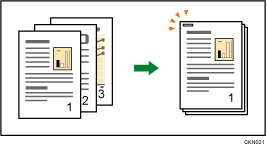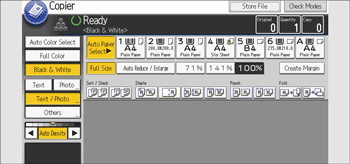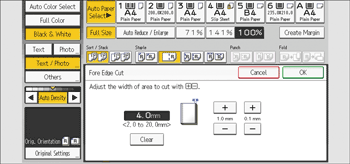Each copy set can be stapled together.

![]()
If you select staple without having the stapler cartridge for saddle stitch set in the booklet finisher, a paper misfeed might occur. Be sure to set the stapler cartridge.
Original orientation and staple position
Place all the originals in the ADF in the orientation in which they can be read normally. When placing the original on the exposure glass, keep the same orientation, but place the original facing downwards.
When the paper that is loaded is the same size and orientation as the original, the relationship between the orientation in which you place the original and the staple positions is as follows. However, if you cannot place the originals in the ![]() orientation, place the originals in the
orientation, place the originals in the ![]() orientation and select unreadable orientation in [Original Orientation].
orientation and select unreadable orientation in [Original Orientation].
Original orientation
|
Original orientation
|
Original orientation
|
Original orientation
|
Staple position*1 |
|
|---|---|---|---|---|---|
Top 1
|
|
|
|
|
|
Slant
|
|
|
|
|
|
Left 2
|
|
|
|
|
|
Top 2
|
|
|
|
|
|
Bottom 1
|
|
|
|
|
|
Top Right 1
|
|
|
|
|
|
Right 2
|
|
|
|
|
|
Center*4
|
|
|
|
|
|
*1 The above tables show staple positioning. The orientation of the paper does not indicate the orientation of delivery.
*2 You cannot staple at this position when copying onto B4 JIS, 8 × 13 or larger.
*3 If you want to staple at this position, select unreadable orientation in [Original Orientation], and then select Top 2.
*4 You can select this position only when Booklet Finisher SR5060 or Booklet Finisher SR 5120 is installed.
![]() Select one of the stapling positions.
Select one of the stapling positions.

When you select a staple position, Sort is automatically selected.
![]() Enter the number of copy sets with the number keys.
Enter the number of copy sets with the number keys.
![]() Place the originals, and then press the [Start] key.
Place the originals, and then press the [Start] key.
![]()
The following type of paper cannot be stapled:
Translucent paper
Transparencies
Label paper (adhesive labels)
Envelopes
Tab stock
High-gloss coated paper
Textured paper
Magnet paper
Metallic/pearl paper
Clear file folder
Synthetic paper
Carbonless paper
Curled paper
Paper of low stiffness
You cannot change staple positions during copying.
When stapling B4 JIS
 , 81/2 × 14
, 81/2 × 14 or larger paper sizes, be sure to extend the paper support plate of the finisher tray.
or larger paper sizes, be sure to extend the paper support plate of the finisher tray.Even if you place different size originals in the ADF, appropriate size of copy paper can be automatically selected and stapled using the Mixed Sizes mode and Auto Paper Select function. Load the paper you want to use in the paper trays beforehand.
If the number of the sheets to be stapled as one set exceeds the capacity of the stapler, copies that are not stapled will be delivered to the tray.
To specify Left 2, Top 2, or Slant together with [2 Originals] or [8 Originals] of [Combine 1 Side], or [4 Originals] or [16 Originals] of [Combine 2 Sides]: specify
 paper for
paper for  orientation originals and specify
orientation originals and specify  paper for
paper for  orientation originals.
orientation originals.To specify Left 2, Top 2, or Slant together with Double Copies: specify
 paper for
paper for  orientation originals and specify
orientation originals and specify  paper for
paper for  orientation originals.
orientation originals.When Left 2 or Top 2 is selected, the following settings are useful to rotate images appropriately:
Auto Reduce / Enlarge or Auto Paper Select
Replace [Auto Tray Switching] with [With Image Rotation] in User Tools.
When Top 1 or Bottom 1 is selected and the paper with the same orientation as the original is not loaded, the image is rotated and the paper with the same size and the different orientation is selected. The maximum original image size that can be rotated is A4 or 81/2 × 11.
Depending on the settings for the Staple, you may not be able to use the Rotate Copy function.
When the original image is rotated, the staple orientation changes by 90 degrees.
If you select Staple: Center, you must specify the Magazine function. The machine staples the paper, and folds it like a book, then delivers the paper folded. For details about the Magazine function, see Booklet/Magazine.
When the number of copies exceeds tray capacity, copying stops. If this happens, remove the copies from the finisher tray to resume copying.
For details about the number of sheets that can be stapled together, the sizes, weights, and orientations of paper that can be stapled, and the number of copy sheets that the output tray can accommodate, see "Specifications for Finisher SR5050", "Specifications for Finisher SR5110", "Specifications for Booklet Finisher SR5060", or "Specifications for Booklet Finisher SR5120", Specifications.
You can change the staple positions shown on the initial screen using the [Input / Output] setting in User Tools. You can also register staple positions on the [Finisher] tab. To select a staple position not displayed on the initial screen, you need to specify one of these settings. For details about staple positions, see "Input / Output", Preparation.
Cutting the fore edge
Use this function to cut the fore edge of a document after it is saddle stitched or folded in half by the finisher.
![]()
This function is available only when you select Center as the stapling position or Half Fold under [Finisher].
![]() Select Center as the staple position.
Select Center as the staple position.
![]() Press [Output/ Customize Function/ Finisher].
Press [Output/ Customize Function/ Finisher].
![]() Press [Fore Edge Cut].
Press [Fore Edge Cut].
![]() Specify the cut length width with [
Specify the cut length width with [![]() ] and [
] and [![]() ], and then press [OK].
], and then press [OK].

![]() Press [OK].
Press [OK].
![]() Enter the number of copy sets using the number keys.
Enter the number of copy sets using the number keys.
![]() Place the originals, and then press the [Start] key.
Place the originals, and then press the [Start] key.
![]()
You can adjust the position of the fore edge cut from 2.0 to 24.0 mm (0.08 to 0.94 inches) in 0.1 mm (0.01 inches) increments.
Empty the trimmer tray if prints are ejected with waste paper stuck to them. For details, see "Removing Waste Paper", Maintenance and Management.
For details about paper sizes, weights, and the number of sheets that can be cut by the trimmer, see "Specifications for Trimmer Unit TR5040" or "Specifications for Trimmer Unit TR5050", Specifications.
For details about Half Fold, see "Half Fold", Fold.

